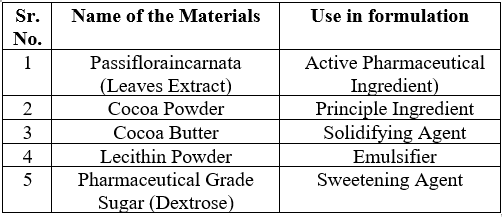Abstract
Children love chocolate the most out of all foods, yet they detest medicine. The goal of the current study is to prevent disease, boost patient desire to take the medication, and create a chocolate formulation of Passiflora incarnate that is palatable for pediatric administration. The ingredients used to produce the chocolate base for this research are pharmaceutical-grade sugar, lecithin, coco butter, and coco powder. The medication is then added to the ready-made chocolate base. One of the many medical qualities of the herbal remedy Passiflora incarnata is its ability to reduce anxiety. In order to provide antianxiety activity, we made attempt to formulate the chocolate with a methanolic extract of Passiflora incarnata. The general appearance, viscosity, weight variation, thickness, hardness, melting point, blooming test, and physical stability of the manufactured medicated chocolate are assessed.
Keywords
MedicatedChocolate,Passifloraincarnata,AntianxietyActivity,Chrysin.
Introduction
The mucosal linings of the nasal, vaginal, rectal, and oral cavities are included in Trans mucosal route. [1]Transmucosal methods offer immediate medication entry into the systemic circulation and a notable reduction in dose-related adverse effects.[2]A variety of goods are made from cocoa (cacao), which is combined with fat (such as cocoa butter) and finely powdered sugar to create solid confections. Caffeine and theobromine are two of the most prominent compounds found in chocolate. All cocoa beans contain these two compounds, which are intimately connected to one another. Chocolate is a very sophisticated and adaptable food that may be mixed to produce impressions of whole new tastes and textures. [3]
Because chocolate includes saturated fat, polyphenols, sterols, di and triterpenes, alcohol-like compounds, and methylxanthines, it is an anhydrous medium that is resistant to microbiological development. Compared to adults, the liking for sweets in infants and children decreases by late adolescence. Acceptance may be hampered by bitter flavor if a distaste of bitterness emerges early in life. Researchers have developed novel solid dosage forms of drug delivery systems, such as medicated chocolate. Children find medicated chocolate more appetizing because it has a more enticing texture and increases patient consent. People with dysphagia and the elderly benefit from this kind of delivery technology. Chocolate is may be combined with medications to create entirety new tastes and textures. Natural to the brain, phenyl ethylamine is referred to as the "love drug" due to its ability to elicit sentiments of contentment and happiness. To identify extremely calorific carbohydrates that are edible, sweet taste is used. To manufacture medicated chocolate, a chocolate base is utilized, and the medication is combined with it. A drug that is mixed into chocolate and subsequently released from it [4]. Its benefits include the potential to avoid pre systemic elimination within the GI tract and to circumvent first pass effects. . The oral chocolate drug delivery system, buccal mucosa is involved .The buccal mucosa exhibits a lower level of enzymatic activity and is more vascularized than the stomach, rectal, and nose mucosa.[5] The genus Passiflora consists of 500 species which are mostly found in warm and tropical regions. The name Passiflora is derived from the Latin word "Passio," which was first identified as a symbol for the "Passion of Christ" by Spanish explorers in 1529. In West India, Mexico, the Netherlands, South America, Italy, and Argentina, this plant was widely utilized in traditional medicine. Among the species in this genus, Passifloraincarnata (Passifloraceae) is the more well-known. The wide-spreading climber Passifloraincarnata, a native of the South East of the United States, is commonly grown in gardens for its beautiful and fragrant flowers. The plant has wiry stems, leaves that are three lobed and serrated, a pale pink flower, and ovoid or globose fruits. Numerous substances, such as alkaloids, phenols, glycosyl flavonoids, and cyanogenic chemicals, are present in passiflora. According to certain studies, it may be useful in the treatment of conditions like cancer, attention-deficit hyperactivity disorder, anxiety, sleeplessness, and the detox from opioids.[6]
Pharmacological Aspects:[9, 10,11,12,13,14,15,16,18,19,20]It is used for cannabinoids reversal, Nicotine reversal, alcohol withdrawal, anticonvulsant activity, antianxiety, anti-asthmatic, antitussive, anticancer and hypertension
Materials and methods: List of Materials and Their Uses in Formulation:
Table 1:List of materials and their uses in formulation

Authentication of the Plant Species:
Verification done through Botanical Survey of India, Koregaon Park, Pune and specimens are sent to India's Botanical Survey.
Preparation of Extract:[21]
Extraction is done using a Soxhlet apparatus. Fresh leaves were collected, washed with water, and allowed to shade dry. A grinder was used to ground the dried leaves. take 60 grams of Passifloraincarnata leaves powder, and soak it in 250 milliliters of methanol using the Soxhlet method for 48 Hrs. The extract is filtered through whatman filter paper and evaporated until it became dry. The extract evaporates to become dry until a dry mass is achieved. After the methanol evaporates, 6.17 g of extract is obtained.
Preliminary Phytochemical Screening of Extract:[22]
The drug's methonolic extract underwent phytochemical analysis using standard protocols to determine the presence or absence of phytochemicals includes test for tannins, alkaloids, carbohydrates, saponins, polyphenols, polysterols, resins, proteins, quinines, and flavonoids.
Preparation of Medicated Chocolate:
Table 2:Formula for Medicated Chocolate Formulation

Preparation of medicated chocolate:[23]
Formulation of chocolate base:
Oven was set to500Cin beaker, sugar and water was taken and kept in a oven for 4-5min,thensyrupwasprepared. Then cocoa butter was taken and kept in a beaker in the oven for1min. Then sugar syrup was removed from the oven, and cocoa powder was added and mixed well.
Preparation of medicated chocolate
The oven was preheated to 50°C. The chocolate base was then heated until it was a liquid that flowed freely. The necessary amount of medication was added. To ensure even mixing, the entire mass was then thoroughly agitated using a magnetic stirrer. After that, we put the mixture in a chocolate mold and chilled it for 15 minutes to solidify.
Evaluation of Medicated Chocolate:[4,23,24]
General Appearance/Organoleptic Characteristics:
Monitoring overall appearance of chocolate formulation, visual identity, and overall "elegance" is essential for consumer acceptance. Achieving this involves measuring a variety of attributes, including the color of the chocolate, odor, taste, and texture.
Determination Viscosity of Medicated Chocolate:
The prepared medicated chocolate's viscosity (in cP) was measured using a Viscolead digital viscometer.
Weight Variation Test:
According to USP, a weight variation study was conducted. From each batch, five formulas were chosen at random and weighed separately.
Thickness/Dimensions of Medicated Chocolate:
Using Vernier calipers, the thickness of five formulations from each batch was measured.
Hardness Test:
Using a Hardness Tester (a Pfizer apparatus), the hardness of the chocolate was determined. Samples are chosen randomly from each batch.
Melting point:
A thermometer is used to compute it. A glass beaker half-filled with water was set on a tripod stand. The burner was positioned underneath the tripod platform to heat the water in the beaker. On top of the beaker, a porcelain dish holding medicated chocolate was placed along with thermometer.
Blooming test:
- Fat bloom:
When a thin layer of fat crystals forms on the surface of the chocolate formulation. This will cause the chocolate to lose its gloss and a soft white layer will appear, giving the finished article an unappetizing look. Fat bloom is caused by the recrystallization of the fats.
- Sugar bloom:
This is a rough and irregular layer on top of the chocolate formulation. Sugar bloom is caused by condensation(when the chocolate is taken out of the refrigerator).This moisture will dissolve the sugar in the chocolate. When the water evaporates afterwards, the sugar recrystallizes in to rough, irregular crystals on the surface. This gives the chocolate an unpleasant look.
- 30°Cfor 11hours,
- Temperatureshiftingfor1hour,
- 18°Cfor11hours,and
- Temperature shifting for 1hour.
A test chocolate formulation observed, after the step at 18°C for 11 hours, whether or not blooming has taken place.
Physical stability:
A test sample of chocolate was stored in a closed container at room temperature for one month in order to examine its physical stability.
RESULT
Phytochemical Test Result:
Phytochemical analysis of Passiflora incarnate revealed the presence of phytochemicals such as Tannins, Alkaloids, carbohydrates, Saponins, Phytosterols, Polyphenols, Proteins, Resins, Quinones, Terpenoids ,and Flavonoids.
General Appearance/Organoleptic Characteristics:
Table 3:GeneralAppearanceofMedicatedChocolate

Determination of viscosity:
Table 4:DeterminationofViscosityofMedicatedChocolate (cP= centipoise)

Weight Variation:
Table5:Weight Variation of Medicated Chocolate

Thickness of Medicated Chocolate:
Table 6:Thickness of Medicated Chocolate

Hardness:
Table 7:Hardness Test of Medicated Chocolate

Melting Point:
Table 8: Melting Point of Medicated Chocolate

Blooming test:
- Fat Bloom Test:-
Table 9:FatBloomTestofMedicatedChocolate

-
Sugar Bloom Test:
Table 10:Sugar Bloom Test of Medicated Chocolate

Physical Stability:
Table 11:Physical stability of Medicated Chocolate

CONCLUSION
Based on the results, it can be concluded that the F3 batch, being an optimized batch, offers a satisfactory physical stability profile and sweetening properties in comparison to other batches. The active ingredient in Passifloraincarnata,chrysin, is used to treat anxiety and alleviate tension. Chocolate's organoleptic qualities work wonders in disguising the off-putting aromas of some active agents and giving active agent compositions a smooth, creamy texture. As a result, the chocolate formulation offers a palatable way to take medications orally.
REFERENCES
- Firriolo,JF;Oralcavity:(1994);AReview.OralSurgMedOralPathol.78(2):189-93.
- Sastry, SV, Nyshdham JR. (2000): Review of formulation used in oral cavity. PharmScience andTechnologyToday.(3):138-145.
- Sharma Mayank, Jain Dinesh Kumar. Chocolate formulation as drug delivery system forpediatrics.IndonesianJournal.14Oct,2012.
- MoumitaPaul,PriyankaRanabhat,DeepikaKhatiwara,ArnabBagchi.Reviewonmedicatedchocolatetakesapatient-centeredapproachtodrugdelivery.JournalofAppliedPharmaceuticalResearch.31,December2021.
- NidhiPatel,SalehaDiwan,KajalShukla.(2015).IAJPS: 2 (6): 1077-1081.
- SitaSharan Patel, Neelesh Kumar Verma, KarunakaranGauthaman. PassifloraincarnataLinn:Areviewonmorphology,phytochemistryandpharmacologicalaspects.PharmacognosyReview.3(5):186-192[2009].
- S. S. Patel, T. S. Mohamed Saleem, V. Ravi, B. Shrestha, N. K. Verma, K. Gauthaman.PassifloraincarnataLinn:Aphytopharmacologicalreview.InternationalJournalofGreenPharmacy.13-09-2008.
- SitaSharanPatel1,NeeleshKumarVerma1,KarunakaranGauthaman.PassifloraincarnataLinn:AReviewonMorphology,PhytochemistryandPharmacologicalAspects.PhcogRev.Vol,3,Issue5,186-192,2009.
- DhawanK,KumarS,SharmaA.Reversalofcannabinoids(delta9-THC)bythebenzoflavone moiety from methanol extract of PassifloraincarnataLinn in mice: Apossible therapyforcannabinoidaddiction.J PharmPharmacol2002;54:875-81.
- DhawanK,KumarS,SharmaA.NicotinereversaleffectsofthebenzoflavonemoietyfromPassifloraincarnataLinninmice.AddictBiol2002;7:435-41.
- DhawanK,KumarS,SharmaA.Suppressionofalcohol-cessation-orientedhyper-anxietybythebenzoflavonemoietyofPassiflora incarnateLinn.Inmice.JEthnopharmacol2002;81:239-44.
- Nassiri-Asl M, Shariati-Rad F, Zamansoltani F. Anticonvulsant effects of arial parts ofPassifloraincarnataextractinmice:Involvementofbenzodiazepineandopioidreceptors.BMC ComplementAlternMed2007;7:26.
- MiyasakaLS,AtallahAN,SoaresBG.Passiflora incarnateforanxietydisorder.Cochrane DatabaseSystRev2007;24:CD004518.
- DhawanK,KumarS,SharmaA.Anti-anxietystudiesonextractsofPassifloraincarnataLinneaus.J Ethnopharmacol2001;78:165-70.
- Brown E, Hurd NS, McCall S, Ceremuga TE. Evaluation of the anxiolytic effects ofchrysin:APassiflora incarnateextract,inthe laboratory at.AANAJ2007;75:333-37.
- DhawanK,KumarS,SharmaA.AntiasthmaticactivityofthemethanolextractofleavesofPassifloraincarnata.PhytotherRes 2003;17:821-2.
- K.DhawanandA.Sharma.AntitussiveactivityofthemethanolextractofPassifloraincarnataleaves.Fitoterapia.73(5):397-99(2002).
- B.G. Katzung. Basic and clinical pharmacology. East Norwalk, Connecticut: Prentice-HallInternationalInc,306(1992).
- D.M. Beaumont, T.M. Mark, R. Hills, P. Dixon, B. Veit and N. Garrett. The effects ofchrysin, a Passiflora incarnateextract, on natural killer cell activity in male Sprague-Dawleyratsundergoingabdominalsurgery.AANAJ.76(2):113-17(2008).
- V.L. Benson, L.M. Khachigian and H.C. Lowe. DNAzymes and cardiovascular disease.BritishJ Pharmacol.154:741–48(2008).
- KamaldeepDhawan,SureshKumar,AnupamSharma.Anti-anxietystudiesonextractsof passiflora incarnate Linneaus.JournalofEthanopharmacology,78 (2001)165-170.
- Mihaela Gabriela Dumitru, AncaGanescu. Research article: Phytochemical screening ofthe methanolic extract of PassifloraincarnataLinn. Annals of the University of CraiovatheChemistrySeriesVolume XLVIII,No.2(2022)43-48.20,December,2022.
- Reddy Sunil,K. Mounika, S. Shalini, A.Venkatesham. Research Article: Design andFabrication of Medicated Chocolate Formulation by Chocolate Drug Delivery System.CurrentPharmaResearch,2010-2020.
- AkshitaGangrade, Sweta S. Koka*, Pravin K. Sharma, DevshreeGayakwad, AshishGupta, G. N. Darwhekar. A review on medicated chocolate for pediatrics.World JournalofPharmaceuticalResearch.11August,2021


 Dipali Hagir *
Dipali Hagir *
 Akanksha Kumbhar
Akanksha Kumbhar











 10.5281/zenodo.13711751
10.5281/zenodo.13711751